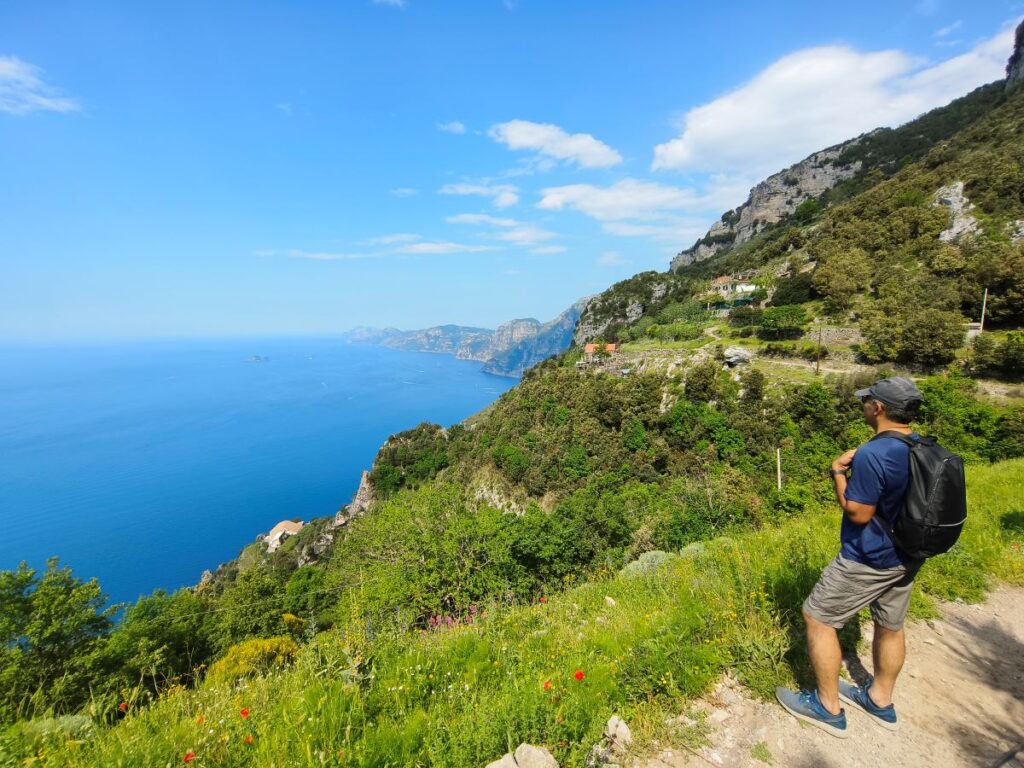Last Updated on February 1, 2024
While most people choose to visit the Amalfi Coast for its sparkling sunshine, rolling waters, pebble beaches, charming trattorias, and the view of the pastel-coloured sea-side towns kissing the azure Mediterranean Sea, the rugged landscape above the coastline promises another scenic world. If you want to enjoy the best views of Italy’s Amalfi Coast, then the Path of the Gods is an immensely popular mountain trail.

Here’s everything you need to know to hike the Path of the Gods.
Amalfi – the paradise on Earth
On the walls of a porticoed alleyway of the Porta della Marina, one of the medieval entrances to the city of Amalfi, there are a few plaques and panels that often go unnoticed by the average tourist. At the entrance of the arch is a 25 cm x 25 cm blue and sepia ceramic panel by Renato Rossi depicting a nautical chart of the trade routes of the Republic of Amalfi in the Mediterranean during the Middle Ages. The panel is under restoration and is now covered by a huge flex that gives information about the restoration project.

We entered the arch to find one panel with the verses of the Song of the Sacrament by Gabriele D’Annunzio. But it was another plaque, which we had read about, that we wanted to see in person. On it, the words of the Italian poet, Renato Fucini, beautifully capture the essence of this magical place called Amalfi.

The translation is
Judgment Day, for the Amalfitans who will go to paradise, will be a day like all the others.
Amalfi, according to Fucini, was nothing less than Paradise!!
If Amalfi was compared to paradise, should it come as a surprise if we told you that the Gods once walked here? And, yes, their footsteps formed an ancient path.
Forging a path

According to a Greek myth, the Greek gods descended from Mount Olympus and ran across the rugged Lattari Mountains to save the legendary Homerian hero, Ulysses, and his crew from the seductive and enchanting songs of the three sirens of Capri. Ulysses and his crew were sailing past the islands Li Galli, an archipelago of three islands between Capri and Positano. The Gods stamped out a path in the process which is now known as Il Sentiero degli Dei or the Path of the Gods.

Shepherds, woodsmen, and farmers have used this path for centuries, herding their sheep and cattle, and carrying wood, cheese, and lemon baskets on their mules across the valleys to the neighbouring village markets.

For a long time, the trail was a refuge for bandits, smugglers, and outlaws. Till the Bourbons built the Amalfi Coastal State Road in the 1850s, this mule track was the only route for locals to get from one village to another.

The ancient mule track got an upgrade when Giustino Fortunato, an Italian politician and keen mountaineer, so awed by its grandeur during one of his walks, christened it Il Sentiero degli Dei. However, it would take more than a century for this breathtaking trail to gain the recognition its name rightfully deserved.

Today, hikers can trace the footsteps of the Gods, farmers, herders, and bandits who forged one of the world’s most beautiful trails.
So, where and what is the Path of the Gods?
The Path of the Gods is a clifftop trail that cuts across Mount Sant’Angelo Ai Tre Pizzi, a massif formed from three peaks that represent the tallest peaks in the Lattari mountain region.

Running parallel to Italy’s famous Amalfi Coast, the trail starts at Bomerano, a hamlet of Agerola, and zig zags across the Lattari mountains, just north of the pretty beach towns of Positano and Praiano.

The path cuts through towering limestone peaks, hidden grottos, rugged cliffs, dense woods, terraced fields growing grape vines, tomatoes, and wheat, crumbling caravanserais, and aromatic lemon orchards finally descending into the village of Nocelle. The maximum altitude of this trail is around 650 m above sea level.

The Path of the Gods presents some of the most exceptional vistas of the Tyrrhenian Sea and the coastal towns of the Sorrentine Peninsula. This is arguably the most beautiful trail with ocean views in Italy’s Campania region.

Ready to walk between the sea and mountains, watching the blue sea, facing the panorama of the Amalfi Coast and Capri for hours?
But, from where does the Path of the Gods trail begin?
The Path of the Gods can be done through various routes and variations.
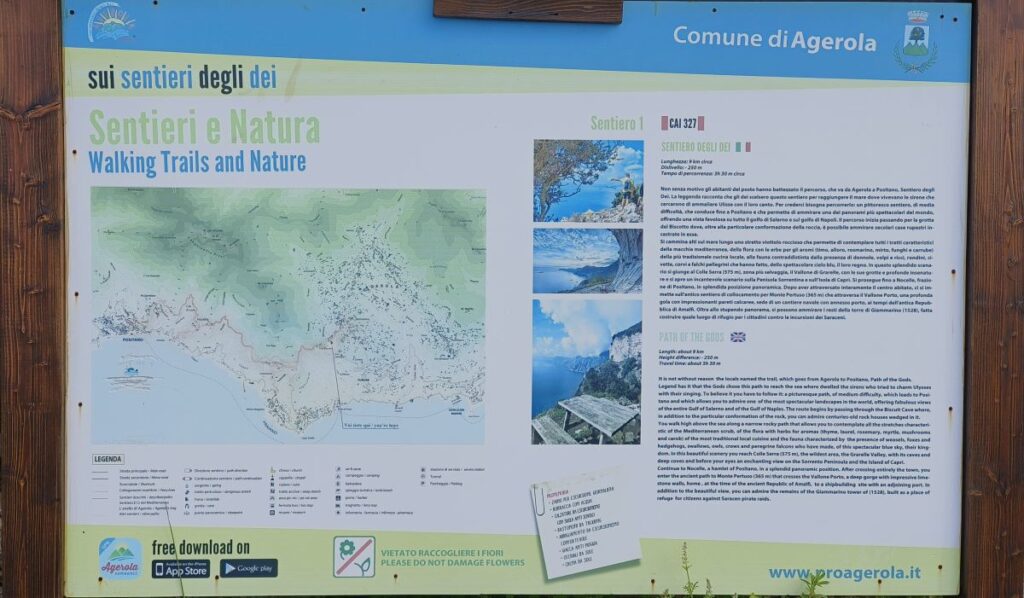
Route 1: The most popular route and the one we followed is to start from the Path of the Gods official trailhead in Bomerano and hike to Nocelle. Most hikers then take the 1800-odd steps all the way down till you hit the Amalfi state road just above the Arienzo beach. Once on the Amalfi Drive, it is a mere 1-kilometer walk down to Positano. From here, you can take a bus or ferry to Amalfi to get back to your base.
Variation 1: Instead of taking the steps down from Nocelle, another route is the longer hike to Positano via Montepertuso. This also involves a few sets of stairs and paved paths.

Route 2: Another way is to do the reverse of Route 1, i.e., from Arienzo, climb up the stairs to Nocelle and walk all the way to Bomerano. It is more challenging and an uphill walk.
Route 3: You can also access the trail from Praiano. But to get to the trailhead from Praiano, you’ll have a steep climb up 1900 odd steps which makes the hike much more strenuous.
We followed Route 1 for more than one reasons:
- We were staying in Agerola, and Piazza Paolo Capasso, from where the hike begins, was only 550 m from our Airbnb.
- The views are better if you start from Bomerano – the ocean is always in front of you.

- Bomerano is in the east and as you walk westwards towards Nocelle, the sun is always behind you; that means less heat and better photographs.
- We did not want to start the day by climbing steep flights of steps or going uphill. The hike becomes more difficult if you start from Praiano or Positano.
- And the best reason – Other than a few ascents, this route is mostly downhill.
How difficult is the Path of the Gods?
The Path of the Gods offers a moderately challenging hiking experience. With many ascents and descents, lots of stairs, and rocky patches spread out over roughly 8 km, hiking the Path of the Gods is certainly more strenuous than a casual walk.

The red and white markers make the trail easy to navigate
While prior hiking experience can be beneficial, the trail is by no means restricted to seasoned hikers. Navigating the trail is straightforward, thanks to the painted tile signs and official red and white markers on wooden posts, trees, and rocks.

To stay on track, follow the reds and whites. The red and white tiles have specific numbers. In case of any emergencies, hikers can dial 118 and inform the operator about their location, which can be determined by referencing the number of the nearest tile marker.
There are rugged sections
The initial segment of the trail is relatively flat, while the latter half becomes steeper and more rugged. This may require some climbing, and there is a brief stretch with consecutive ascents and descents.

The paths are exposed in some sections
If you have a fear of heights or experience vertigo, you may find this hike a bit challenging, as it traverses exposed ridges and narrow paths with panoramic views of the coastline.

And there are steep stairs!
The descent from Nocelle via stairs is a bit challenging and not recommended for those with sensitive joints and knee issues. However, wearing comfortable shoes and knee pads would make your descent less tiresome and save you from painful blisters and leg cramps. Carry a trekking pole for support. The stairs are mostly through shaded areas, which gives respite to the blazing sun.

How long does it take to walk the Path of the Gods?
The distance and duration will depend on the route you choose. It generally takes between 3 to 5 hours, depending on the season and your fitness level. The official marker said 4 hours and 20 minutes from Bomerano to Positano. However, getting to Bomerano from where you are staying and getting back to your starting point from Nocelle or Positano can add up. We took exactly 5 hours from Bomerano to Positano, including a few water and snack breaks and a lot many photography breaks.

The best time to hike the Path of the Gods
The Path of the Gods trail can be hiked all year round. We visited in late May and the days were quite sunny with the temperature hovering around 25ºC at noon time. It had rained the previous night and it was cooler when we started, but we did feel the heat after 11 a.m.
Spring – April to June
The spring months of April, May, and June have good weather. It is not as crowded as in July or August when the schools in Italy close and the locals hit the coast. Spring is especially lovely as the wildflowers are in full bloom.

Autumn – September to November
The autumn months (September, October, and November) are also favourable for hiking the Path of the Gods.
You can hike the Path of the Gods in winter. However, many hotels and restaurants close, and the weather can be cool and wet. The summer months are very hot and crowded.
The ideal time of the day to do the Path of the Gods
Start your hike early in the morning, ideally around 8 or 9 a.m. This way you get to Nocelle before noon, in time to beat the midday heat. And there are large stretches of path without any trees and shade.
How to get to Bomerano – the trailhead of Path of the Gods?
By Bus
The best way to reach Bomerano is by bus. Buses are available to Bomerano from Amalfi. If you are staying in any other town on the Amalfi coast, you will first have to take a bus to Amalfi and then take a bus from Amalfi to Bomerano. It takes about 40 minutes by bus to get to Bomerano from Amalfi.

The local bus company is SITA and you need to buy bus tickets in advance from Tabacchis or convenience shops. The SITA bus ticket costs €2.20 for a one-way journey lasting less than 45 minutes.

Buy your bus tickets in advance if you want an early start for the hike. For more details on the bus schedule, check here.
By Car
Driving your car or opting for a car rental is a convenient means of reaching Bomerano, yet it does come with certain drawbacks. The roads can experience heavy traffic during the peak season. And, navigating the Amalfi Coast poses considerable challenges due to its cliffside roads, winding hairpin turns, and treacherous precipices that plunge toward the sea.

Free public parking is available along the road right next to the sign marking the beginning of the Path of the Gods.
What to carry on the Path of the Gods trek
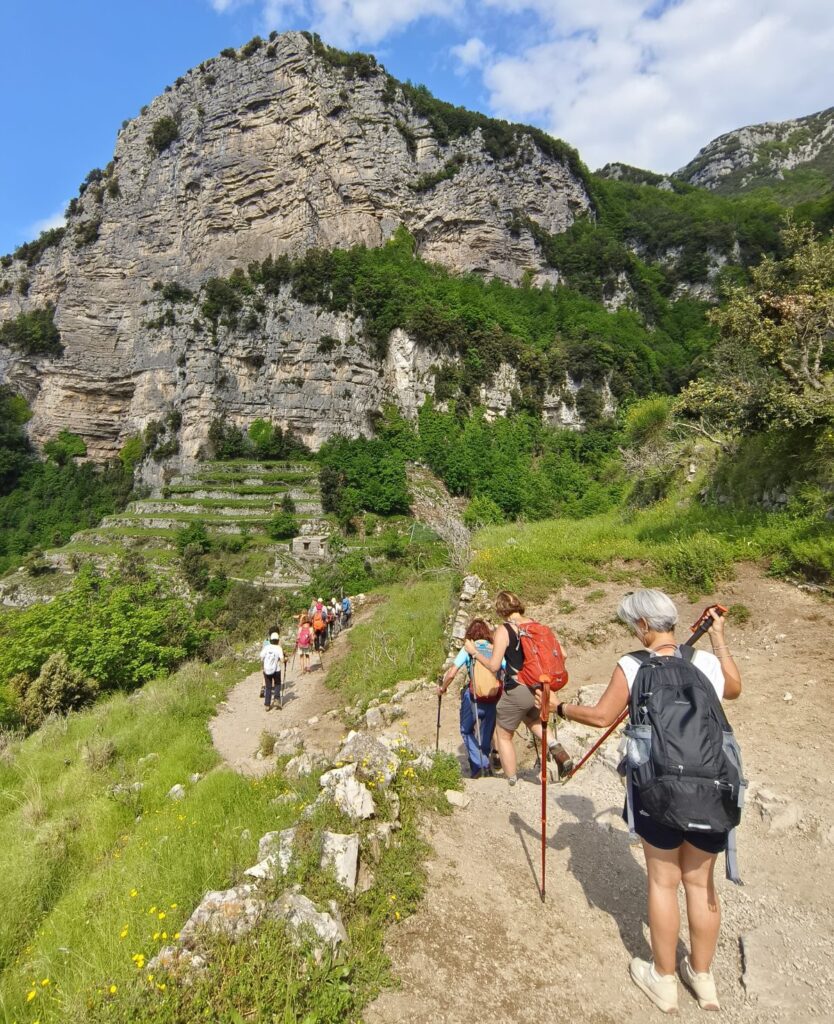
- Wear comfortable trekking shoes. Opt for comfortable clothes, preferably made from cotton rather than synthetic materials to keep you cool and ventilated.
- A small day pack to carry your snacks and water.
- Bring along some snacks to keep you energised during the ramble.
- To keep yourself hydrated, carry a bottle of water. You can fill your bottle from the different sources of water found along the way.
- For sun protection do not forget to carry your sunscreen, hat, and sunglasses.
- Hiking poles (optional).

Quick facts
- Starting Point: Piazza Paolo Capasso, Bomerano
- Ending Point: Positano
- Distance: Around 8 km depending on where you end your hike in Positano
- Time taken: 5 hours
- Difficulty: Easy to moderate
Point-to-point distances of the Path of the Gods (as per Google Maps)

- Bed and Breakfast Haidi House to Piazza Paolo Capasso: 550 m
- Piazza Paolo Capasso to the trailhead of Sentiero Degli dei: 850 m
- Trailhead of Sentiero degli Dei to Nocelle Lemon point: 4.7 km
- Nocelle Lemon point to Arienzo (Amalfi Drive): 1 km (1700+ steps)
- Arienzo to Positano ferry station: 1.7 km
- Total: 8.7 km
Setting on the route between the sea and mountains
We did this hike in the last week of May 2023, during our visit to the Amalfi Coast.
As the morning sun cast its golden rays upon the rain-drenched Agerola village, we found ourselves embarking on an adventure like no other. We were about to set foot on the famed Path of the Gods, a historic trail that winds its way along the stunning coastline of Southern Italy.

As we laced up our hiking shoes and huffed and puffed our way up the road from Haidi House (our Airbnb), a sense of wonder hit our souls; we were ready to immerse in the natural beauty and cultural heritage of this enchanting region.

It had rained the previous evening; the grass was still glistening in the early-morning dew. We had an early breakfast from Haidi House, a family-owned Airbnb that is nestled outside the Agerola village, before setting out to the trailhead.

Other than being the welcoming pad to hikers wishing to go on the Path of the God’s hike, Agerola is also famous for its fior di latte cheese or freshly pulled-curd cheese made from raw cow’s full milk. Agerola is nestled among the Lattari Mountains and the word Lattari comes from the Italian for latte or milk.
The cheese is especially well-suited as pizza toppings as it does not release much moisture during the cooking process, preventing the pizza from becoming excessively soggy. Its elastic texture provides the perfect level of stringiness while maintaining a satisfying crunch in every bite. The evening before, we had savoured a pizza topped with this distinctive Agerola cheese, sun-dried tomatoes, and basil leaf.

Bomerano – the trailhead of the Path of the Gods
A short uphill walk from Haidi House led us to Piazza Paola Capasso. This small square is lined with a few cafes, Airbnbs, souvenir shops, and convenience stores. If you have to grab a coffee or stock up on your snacks, this is the place.

There is a store from where you can buy or rent trekking gear – raincoats, trekking poles, broad-brimmed hats, water bottles, etc.

Once you have reached the square, look out for a huge information board set up by the Municipality of Agerola. Here, there is all the information regarding the Path of the Gods as well as the other many hikes in the region, and the do’s and don’ts you need to follow while hiking on this beautiful trail. There are signs pointing in the direction of different trails that start from the piazza.

The Path of the Gods’ start-point is well marked, and it took us only a few minutes to find the red and white way marker and a sign that indicates the way. Look out for the sign that says – ‘Sentiero degli Dei’ (CAI 327).

The trailhead for the Path of the Gods starts right in front of the information board. The narrow stone-clad road goes a bit downhill taking us out of the residential area. We passed pretty houses with colourful flowerpots and terraced farmlands growing grapes, tomatoes, and aromatic herbs.
After about 300 meters, we reached another sign board that confirmed we were on the right track. A few wooden steps and a small wooden bridge later, we hit the Sentiero degli Dei road. After an uphill hike, we arrived at the official trailhead for the Path of the Gods.

The Path of the Gods trail begins
From a distance, we could see a huge sign with the words ‘Benvenuti sul sentiero degli Dei‘, carved into the rocks, that welcomed us to the Path of the Gods trail.

The path gradually ascended, revealing the vast azure Mediterranean Sea on our left. This was our first chance to admire the big blue expanse from several hundred meters above. From this vantage point, a scattering of terraced farms nestled among the surrounding cliffs came into view.

On the same rock, we found two colourful ceramic panels that quoted Italo Calvino and D.H. Lawrence. Since time immemorial, nature has inspired many great poets; these two writers have honoured the beauty of Amalfi through their words. Translations copied from the net
Starting from the Path of the Gods, that road suspended over the magical gulf of “Sirens”, marked even today by memory and myth.
Italo Calvino
Is this the view that from on high along the Path of the Gods, opens to our sight: it is the picture of the great loop of the Amalfi coastline that looks towards the west, towards the Island of Capri, that precipitous coast, steamy, hot, with the crystalline mountains where the gods of today are forsaken and you find a lost self again. Mediterranean, before you.
D.H. Lawrence

Grotta del Biscotto
After the vantage point, the trail goes down. As we climbed down the wide steps, we found a unique rock formation on the right side. The Grotta del Biscotto is also known as the biscuit cave as it resembles an Italian rusk. This is where there used to be ancient dwellings embedded into the cliff. We found an abandoned century-old stone house almost embedded and suspended from the cliff.

Initially, the imposing cliffs above were intimidating, their sheer size and breathtaking beauty overpowering our senses. We found it quite challenging to concentrate on our steps as we were irresistibly drawn to the awe-inspiring vistas. We even wondered whether we would be able to complete the hike in the estimated four to five hours. Especially, since we were barely managing to walk a few meters without pausing to soak in the stunning panoramas.

Flora, fauna and Homo sapiens
The characteristic scents of the Mediterranean scrub hung in the air, and the wild flowers brought the slopes to life. Glad we hiked during the spring months; there were daisies, buttercups, poppies, cowslips, dandelions, wisteria, and many other flowers dancing in the cool breeze.

We also noticed a continuous rustling sound as numerous lizards kept darting in and out of the rocks and shrubbery.
Being on one of the top 10 most popular and Instagrammable hikes on the Amalfi coast, we knew it was not the place to go for some quiet time. During our journey, we encountered many hikers, sometimes we were hiking elbow to elbow with others.

There were huge groups led by guides, a few couples, and many families in tandem. Oddly enough, we found a few hikers heading in the opposite direction, from Nocelle to Bomerano. This struck us as rather peculiar, especially when the most breathtaking panoramic views lie in the opposite direction.
Colle la Serra
We arrived at Colle la Serra, an intersection located at 578 m asl, and now there was a decision to be made. Here the trail splits into two paths. You can choose between – 327 (the left path) and 327A (the right path). Either way, the two trails meet back up later, so you’ll end up in the same place!

The higher trail – 327A – is less exposed and rockier with few undulations. This path is a better option for hikers who want a bit of shade and less company.
The lower trail – 327 – is more scenic, offering breathtaking vistas of the rugged coastline and the vast expanse of the sea.

A gravel path and a few stone steps led us to yet another intersection with a sign indicating directions for Nocelle and Positano to the right and Praiano to the left. You can fill up your water bottles from the water source here and enjoy the never-ending vistas of the coastal wonderland.

The lower trail – 327
We followed the lower trail. After filling up our water bottles and posing for a few pictures, we started our descent.
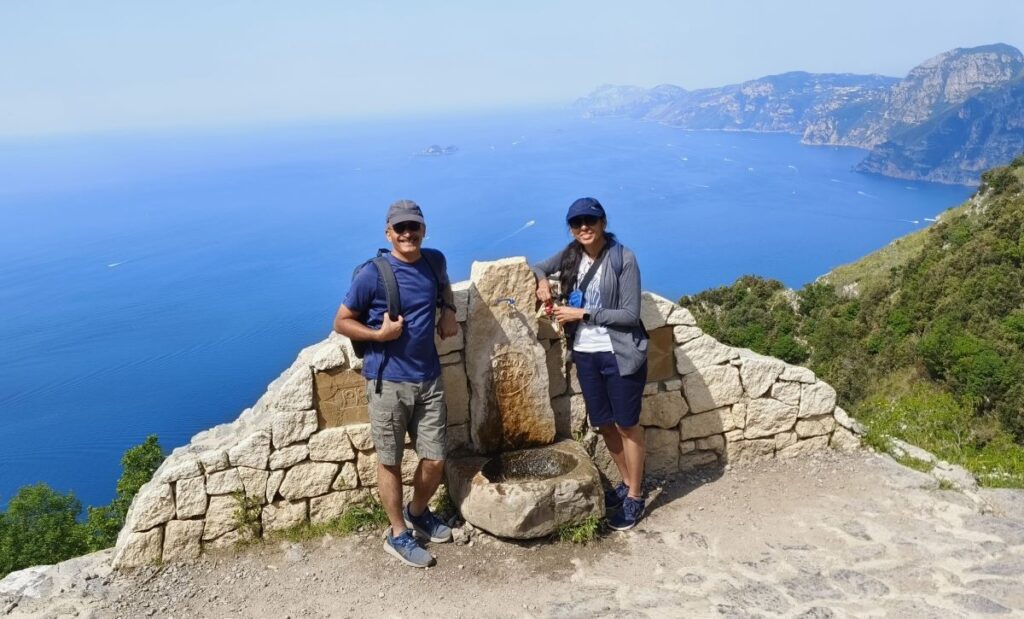
Once we passed the intersection, the path gradually narrowed and transformed into a more picturesque route, creating the illusion of floating above the blue mass of expansive waters. The narrow dirt path was rocky in certain stretches, but it remained quite manageable, even on the slopes. In some places, the path got very narrow and exposed, with steep and dangerous drops below; we held onto the wooden safety rails wherever they were placed.

When we looked back, the little houses of the village of Praiano, stacked on a cliff, came into view. In contrast to the white houses, the lime-yellow 15th-century Church of St. Gennaro, incidentally the only building of baroque architecture that you will find along the Amalfi Coast, looked grand from above.

When we looked forward, even the furthest tip of the peninsula was visible, the isle of Capri, the last point of land the eye could see.
Path of the Gods – one of the finest coastal walks
Our enthusiasm only intensified as we moved forward. The reality that unfolded before us surpassed all our expectations. It’s at this precise moment that one comprehends why the Path of the Gods is hailed as one of the finest coastal walks. The dramatic peninsula extends for miles, casting a majestic presence. The various shades of turquoise in the water are nothing short of striking. Around every corner is a view of the sparkling Mediterranean, or a bird’s eye glimpse of the coastal towns and villages, like so many dolls’ houses interspersed with the dark green of olive tree foliage.

It was a surreal experience to be walking on a trail that had been traversed by generations before us. Today, we can easily climb up this path, unaware of the time and effort it had taken to pave the path here. Someone would have dragged a boulder or heaved a log downhill or uphill to align it with the others, one step in a staircase of many. Sometimes, nature played a part; the roots of the trees, over time, formed natural steps along the route.
Amenities on the Path of the Gods trail
There were more water sources on the way with clear indications that the water was potable. With every twist and turn, we had the opportunity to appreciate the landscapes from a new angle and witness the town of Positano get larger and nearer, which was to be our ultimate destination for the trek.

Thanks to the painted tile signs and the official red and white markers on wooden posts, trees, and rocks, hiking the trail was pretty straightforward. We just had to follow the red and white indicators.
There were a few wooden benches placed at vantage points, to take a break and savour the scenic beauty.

A short walk from Colle Serra, we found a small cafe. We did not venture inside, but there was a menu board displayed outside that showed a variety of slushes and granitas. We did not find any toilets unless there was one inside the cafe.

Changing landscapes
We kept walking. At times I was caressing wildflowers, a few minutes later, I was walking through olive groves over damp mud to the tune of tireless crickets.
Later, I was navigating huge boulders walking on all fours, envying the lady with long legs in front of me who was hopping from one rock to another with her hands tucked into her pockets!

A Delightful Interlude: Nocelle
The trail then descended, meandering away from the coast. We were approaching Nocelle, a peaceful village tucked away in the cliffs. The segments of shaded woodland, mainly oak and chestnut trees, offered respite from the noon heat, though you lose some of the wonderful views.

Once the wood section ended, we were back to civilisation. The dirt path gave way to cemented narrow streets, instead of the huge boulders there were cute villas, B & B’s, restaurants, and cafes with beautiful ceramic art on the walls. And cats…. At least half a dozen of them, minding their business.

Upon reaching Nocelle, we took a moment to catch our breath and soak in the tranquility of the surroundings. Despite the flux of tourists visiting Amalfi and the continuous development in the neighbouring hamlets, Nocelle had sort of a sleepy vibe and had kept its authentic charm intact.

There was a small piazza with a few trees and benches and a huge terrace that overlooked the sea and had an unobstructed view of Positano.

There was a refreshment bar called Lemon Point and a small church, the Santa Croce Church (Chiesa di Santa Croce). We had an ice-cold slushy lemon granita before making our way down the 1,700+ steps to Positano. This is exactly what we needed to confront the final and arguably most demanding segment of this hike!

The Descent from Nocelle to Positano
The final stretch of the hike took us on a steep descent towards Positano. The descent towards Positano was exhilarating and challenging, as we navigated through the stone stairways and hidden coves.
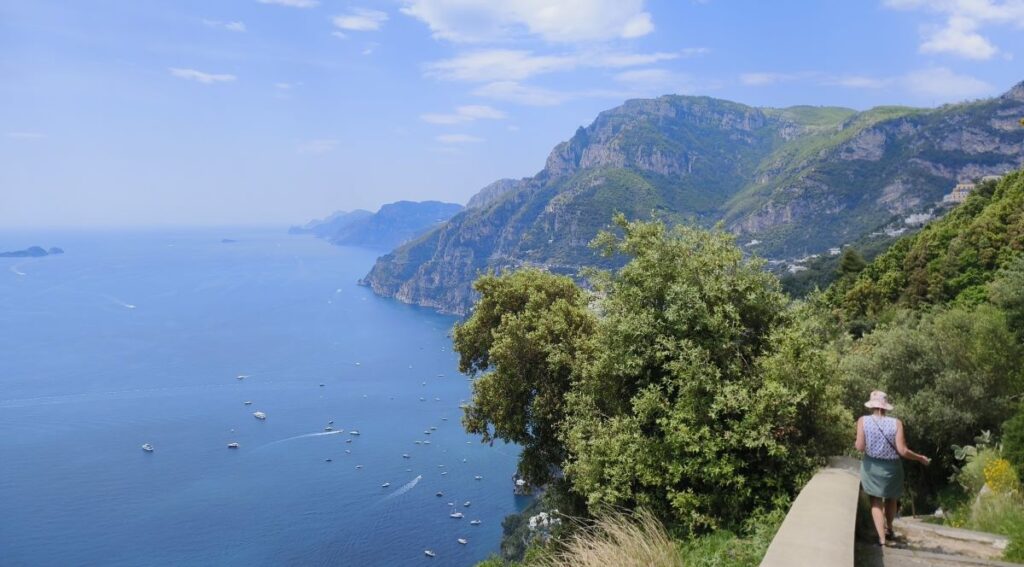
There were very few flat sections in between. The trail led us past ancient vineyards and terraced lemon groves, and the scent of citrus fruits hung in the air. It felt like a sensory journey, with the beauty of the surroundings intermingling with the scent of nature.

We were so thankful that we were going down the steps. We saw a few hikers climbing up the steps, huffing and puffing and turning red from the heat.

Before long, we hastened our pace, eager to complete this final stretch which turned out to be significantly more difficult on our legs than we expected. The sound of the motor vehicles became evident and a few flights of steps later, the Amalfi State Road was visible.

It took a good 30 minutes to climb down the steps from Nocelle. Now, all we had to do was to walk down this beautiful highway to reach Positano.

Positano – The town’s vibrant atmosphere

As we walked downhill, along the road, the turquoise sea shimmered below, guiding us toward the vibrant town of Positano ahead. We were just above the Arienzo beach; the beach chairs and umbrellas looked miniscule from above.
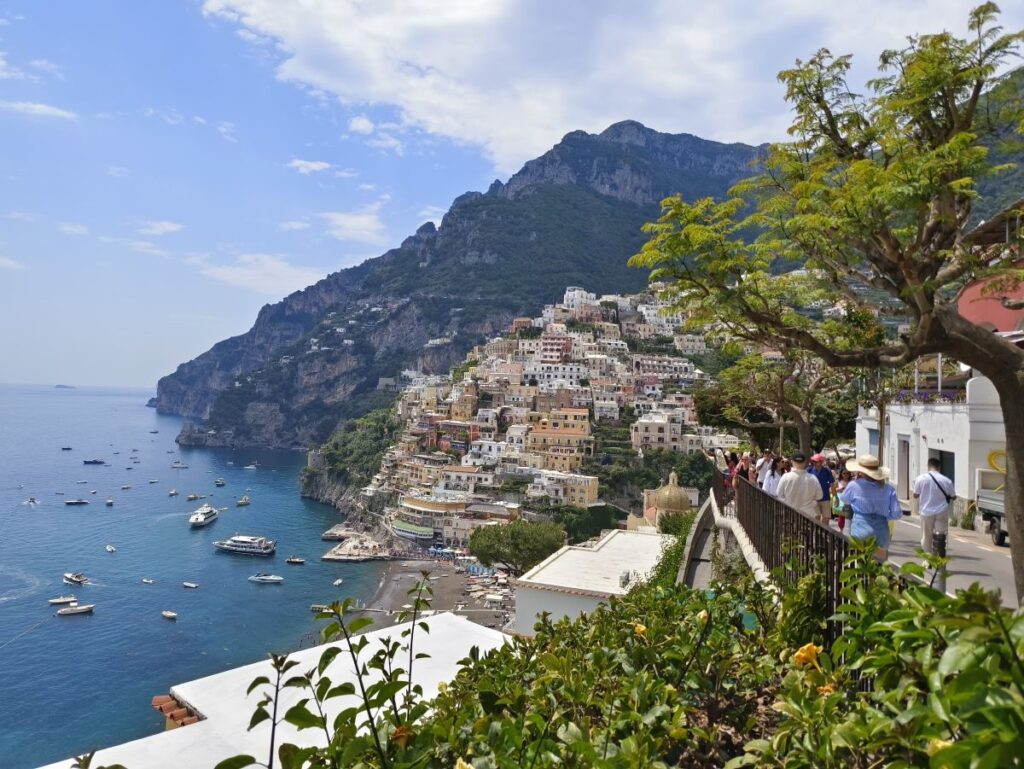
Arriving in Positano, we were greeted by the lively atmosphere of the town. The narrow streets were abuzz with activity, and the pastel buildings seemed to embrace us with warmth. We took some time to explore the town’s quaint boutiques, ceramic emporiums, Limoncello shops, and souvenir shops. We picked up a few souvenirs to remind us of this day. The streets were adorned with vibrant food stalls offering an abundance of delectable, fresh Italian cuisine.

For our return journey, we took a ferry from Positano to Amalfi and then a bus back to Agerola. The ferry station was located near the Mariana Grande Beach. We had to pass through a bustling piazza where the Basilica Santa Maria Assunta was located. The central yellow, green, and blue majolica-tiled dome made the 10th-century church stand out against the town’s pretty pastel buildings. The Basilica has a bell tower and an impressive facade.

Final thoughts
As we sat on the ferry, reflecting on the beauty of the trail, we realized that the Path of the Gods had lived up to its name. From the ferry, we tried to spot the trail on the high mountain cliffs way above the pretty houses stacked precipitously along the coastline.

It had been an inspiring journey, filled with moments of awe and wonder. The Amalfi Coast had etched itself into our hearts. This day would forever be treasured as a glimpse of paradise on Earth.

If you happen to be in Amalfi, make sure to add the Path of the Gods to your bucket list. It is truly an unforgettable experience to explore this ancient path, which was once forged by the Gods and lies wedged between the high cliffs and the blue sea.


